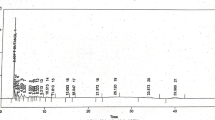Abstract
Caper plant (Capparis spinosa) extracts have been associated with diverse biological activities including anti-oxidant properties. In this work, we characterized the hydro-ethanolic extract obtained from C. spinosa leaves [hydroethanolic extract of C. spinosa (HECS)] by analyzing the content in anti-oxidant compounds such as polyphenols, flavonoids and anthocyanins. Further, we evaluated HECS antioxidant activities in vitro using bleaching of 1,1-diphenyl-2-picrylhydrazyl radical and ABTS test as well as by pretreatment of HeLa cells exposed to Fe2+ or H2O2. Our findings indicate that HECS contains high amount of total phenolic compounds and high levels of flavonoids and anthocyanins. Furthermore, HECS exhibited antioxidant activity in both chemical and biological tests. Specially, pretreatment of HeLa cells with different concentrations of the extract conferred protection against lipid peroxidation and modulated activities of two antioxidant enzymes, SOD and catalase. These results revealed HECS antioxidant effects and suggest that C. spinosa leaves are a potential source of natural antioxidant molecules with possible applications in industry and medicine.



Similar content being viewed by others
Abbreviations
- ABTS:
-
2,2'-azino-bis(3-ethylbenzothiazoline-6-sulphonic acid)
- DM:
-
Dry matter
- DPPH:
-
1,1-Diphenyl-2-picrylhydrazyl
- FCS:
-
Foetal calf serum
- GAE:
-
Gallic acid equivalent
- HECS:
-
Hydroethanolic extract of Capparis spinosa
- MDA:
-
Malondialdehyde
- CS:
-
Capparis spinosa
- PBS:
-
Phosphate buffer saline
- ROS:
-
Reactive oxygen species
- SOD:
-
Superoxide dismutase
- TBA:
-
Thiobarbuturic acid
- TBARs:
-
Thiobarbuturic acid reactive species
- TEAC:
-
Trolox equivalent antioxidant capacity
- TEP:
-
1,1,3,3-Tetraethoxypropane
References
Aebi H (1984) Catalase in vitro. Methods Enzymol 105:121–126
Albayrak S, Aksoy A, Sagdic O, Hamzaoglu E (2010) Compositions, antioxidant and antimicrobial activities of Helichrysum (Asteraceae) species collected from Turkey. Food Chem 119:114–122. doi:10.1016/j.foodchem.2009.06.003
Bonina F, Puglia C, Ventura D, Aquino R, Tortora S, Sacchi A, Saija A, Tomaino A, Pellegrino ML, de Caprariis P (2002) In vitro antioxidant and in vivo photoprotective effects of a lyophilized extract of Capparis spinosa L. buds. J Cosmet Sci 53:321–335
Bouaziz M, Dhouib A, Loukil S, Boukhris M, Sayadi S (2009) Polyphenols content, antioxidant and antimicrobial activities of extracts of some wild plants collected from the south of Tunisia. Afr J Biotechnol 8:7017–7027
Bouaziz M, Grayer RJ, Simmonds MSJ, Damak M, Sayadi (2005) Identification and antioxidant potential of flavonoids and low molecular weight phenols in olive cultivar chemlali growing in Tunisia. J Agric Food Chem 53:236–241. doi:10.1021/jf048859d
Bouaziz M, Jemai H, Khabou W, Sayadi S (2010) Oil content, phenolic profiling and antioxidant potential of Tunisian olive drupes. J Sci Food Agric 90:1750–1758. doi:10.1002/jsfa.4013
Calis I, Kuruuzum A, Ruedi P (1999) 1H-Indole-3 acetonitrile glycosides from Capparis spinosa fruits. Phytochemistry 50:1205–1208. doi:10.1016/S0031-9422(98)00669-4
Cao Y-L, Li X, Zheng M (2010) Capparis spinosa protects against oxidative stress in systemic sclerosis dermal fibroblasts. Arch Dermatol Res 302:349–355. doi:10.1007/s00403-009-0998-7
Eddouks M, Lemhadri A, Michel J-B (2004) Caraway and caper: potential anti-hyperglycaemic plants in diabetic rats. J Ethnopharmacol 94:143–148. doi:10.1016/j.jep.2004.05.006
Eddouks M, Lemhadri A, Michel J-B (2005) Hypolipidemic activity of aqueous extract of Capparis spinosa L. in normal and diabetic rats. J Ethnopharmacol 98:345–350. doi:10.1016/j.jep.2005.01.053
Fuleki T, Francis FJ (1968) Determination of total anthocyanin and degradation index for cranberry juice. J Food Sci 33:78–83
Germanò MP, De Pasquale R, D’Angelo V, Catania S, Silvari V, Costa C (2002) Evaluation of extracts and isolated fraction from Capparis spinosa L. buds as an antioxidant source. J Agric Food Chem 50:1168–1171
Jiang X, Chen F (1992) The effect of lipid peroxides and superoxide dismutase on systemic lupus erythematosus: a preliminary study. Clin Immunol Immunopathol 63:39–44
Lee J, Durst RW, Wrolstad RE (2005) Determination of total monomeric anthocyanin pigment content of fruit juices, beverages, natural colorants, and wines by the pH differential method: collaborative study. J AOAC Int 88:1269–1278
Levizou E, Drilias P, Kyparissis A (2004) Exceptional photosynthetic performance of Capparis spinosa L. under adverse conditions of Mediterranean summer. Photosynthetica 42:229–235. doi:10.1023/B:PHOT.0000040594.85407.f4
Makris DP, Rossiter JT (2002) Effect of natural antioxidants on heat-induced, copper(II)-catalysed, oxidative degradation of quercetin and rutin (quercetin 3-O-rutinoside) in aqueous model systems. J Sci Food Agric 82:1147–1153. doi:10.1002/jsfa.1159
Matsuyama K, Villareal MO, El Omri A, Han J, Kchouk ME, Isoda H (2009) Effect of Tunisian Capparis spinosa L. extract on melanogenesis in B16 murine melanoma cells. J Nat Med 63:468–472. doi:10.1007/s11418-009-0355-3
Mozaffarieh M, Sacu S, Wedrich A (2003) The role of the carotenoids, lutein and zeaxanthin, in protecting against age-related macular degeneration: a review based on controversial evidence. Nutr J 2:20. doi:10.1186/1475-2891-2-20
Re R, Pellegrini N, Proteggente A, Pannala A, Yang M, Rice-Evans C (1999) Antioxidant activity applying an improved ABTS radical cation decolorization assay. Free Radic Biol Med 26:1231–1237
Shahidi F, Naczk M (2003) Phenolics in food and nutraceuticals, 2nd edn. CRC Press, Boca Raton
Singleton VL, Rossi JA (1965) Colorimetry of total phenolics with phosphomolybdic–phosphotungstic acid reagents. Am J Enol Vitic 16:144–158
Tlili N, Khaldi A, Triki S, Munné-Bosch S (2010) Phenolic compounds and vitamin antioxidants of caper (Capparis spinosa). Plant Foods Hum Nutr 65:260–265. doi:10.1007/s11130-010-0180-6
Trombetta D, Occhiuto F, Perri D, Puglia C, Santagati NA, De Pasquale A, Saija A, Bonina F (2005) Antiallergic and antihistaminic effect of two extracts of Capparis spinosa L. flowering buds. Phytother Res 19:29–33. doi:10.1002/ptr.1591
Zhishen J, Mengcheng T, Jianming W (1999) The determination of flavonoid contents in mulberry and their scavenging effects on superoxide radicals. Food Chem 64:555–559. doi:10.1016/S0308-8146(98)00102-2
Acknowledgments
The present investigation was supported financially by the ministry of high education and scientific research—TUNISIA.
Author information
Authors and Affiliations
Corresponding author
Rights and permissions
About this article
Cite this article
Mansour, R.B., Jilani, I.B.H., Bouaziz, M. et al. Phenolic contents and antioxidant activity of ethanolic extract of Capparis spinosa . Cytotechnology 68, 135–142 (2016). https://doi.org/10.1007/s10616-014-9764-6
Received:
Accepted:
Published:
Issue Date:
DOI: https://doi.org/10.1007/s10616-014-9764-6




